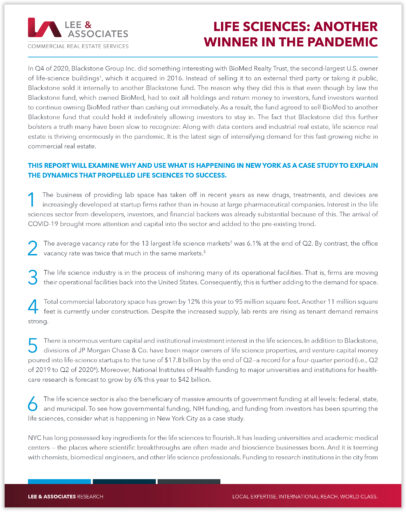In Q4 of 2020, Blackstone Group Inc. did something interesting with BioMed Realty Trust, the second-largest U.S. owner of life-science buildings1, which it acquired in 2016. Instead of selling it to an external third party or taking it public, Blackstone sold it internally to another Blackstone fund. The reason why they did this is that even though by law the Blackstone fund, which owned BioMed, had to exit all holdings and return money to investors, fund investors wanted to continue owning BioMed rather than cashing out immediately. As a result, the fund agreed to sell BioMed to another Blackstone fund that could hold it indefinitely allowing investors to stay in. The fact that Blackstone did this further bolsters a truth many have been slow to recognize: Along with data centers and industrial real estate, life science real estate is thriving enormously in the pandemic. It is the latest sign of intensifying demand for this fast-growing niche in commercial real estate.
THIS REPORT WILL EXAMINE WHY AND USE WHAT IS HAPPENING IN NEW YORK AS A CASE STUDY TO EXPLAIN THE DYNAMICS THAT PROPELLED LIFE SCIENCES TO SUCCESS.
-
The business of providing lab space has taken off in recent years as new drugs, treatments, and devices are increasingly developed at startup firms rather than in-house at large pharmaceutical companies. Interest in the life sciences sector from developers, investors, and financial backers was already substantial because of this. The arrival of COVID-19 brought more attention and capital into the sector and added to the pre-existing trend.
-
The average vacancy rate for the 13 largest life science markets2 was 6.1% at the end of Q2. By contrast, the office vacancy rate was twice that much in the same markets.3
-
The life science industry is in the process of inshoring many of its operational facilities. That is, firms are moving their operational facilities back into the United States. Consequently, this is further adding to the demand for space.
-
Total commercial laboratory space has grown by 12% this year to 95 million square feet. Another 11 million square feet is currently under construction. Despite the increased supply, lab rents are rising as tenant demand remains strong.
-
There is enormous venture capital and institutional investment interest in the life sciences. In addition to Blackstone, divisions of JP Morgan Chase & Co. have been major owners of life science properties, and venture-capital money poured into life-science startups to the tune of $17.8 billion by the end of Q2—a record for a four-quarter period (i.e., Q2 of 2019 to Q2 of 20204). Moreover, National Institutes of Health funding to major universities and institutions for health-care research is forecast to grow by 6% this year to $42 billion.
-
The life science sector is also the beneficiary of massive amounts of government funding at all levels: federal, state, and municipal. To see how governmental funding, NIH funding, and funding from investors has been spurring the life sciences, consider what is happening in New York City as a case study. READ MORE >

